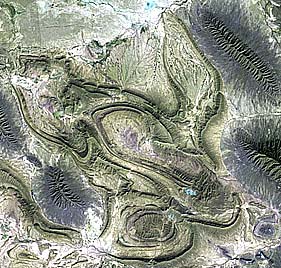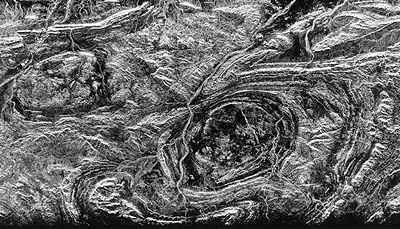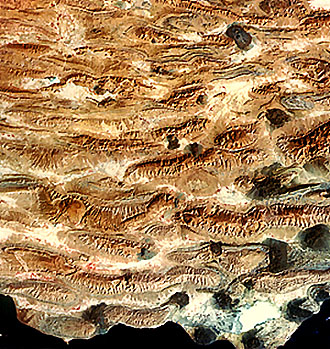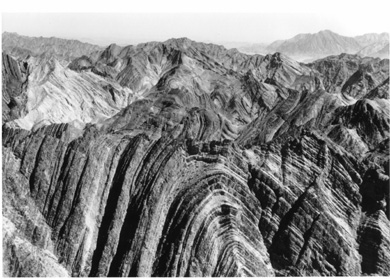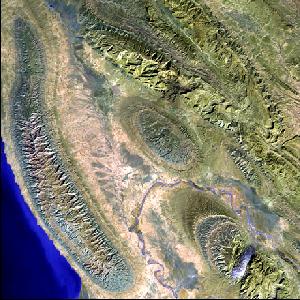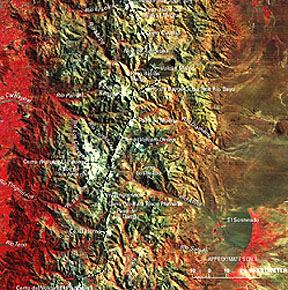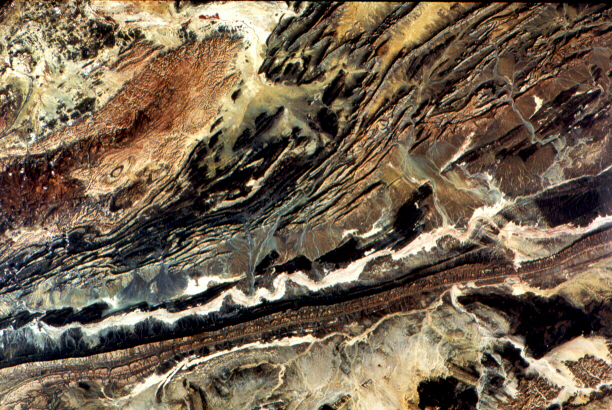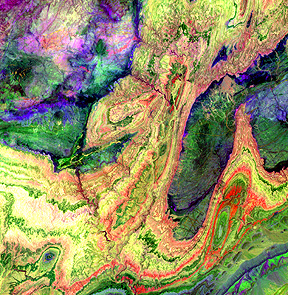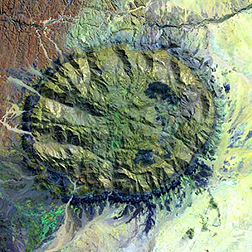
On a somewhat larger ground scale, look next at the folding shown in this outcrop photo of volcanic ash layers in Japan. There is an erosional discontinuity (unconformity) that separates earlier folding in the lower half from folding (above) after later ash flows were deposited.
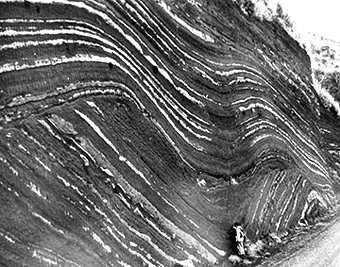
The folds shown above occur in supracrustal rocks, those above what is commonly called the "basement" rocks that make up the underlying (generally older) core of a continent (in the craton) and are composed of metamorphic rocks mixed with igneous rocks. At one time, before reaching the present surface, these deeply buried rocks were hot and "soft" (plastic-like). Under those conditions, layers in these crystalline rocks are deformed by squeezing and crumpling of heated units under high pressure as metamorphism proceeds. Here is an example of this type of folding (technically, called ptygmatic); note the hammer for scale. This folding is normally not detectable by space sensors (except those with very high spatial resolution).
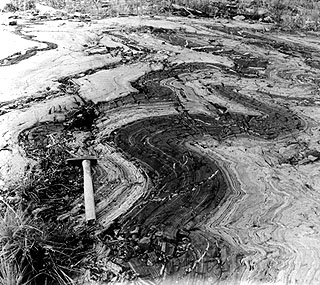
However, larger features at
regional scales often show obvious patterns of geometric curvature or displacement
that stand out in relation (context) to neighboring features, as best displayed
in space images covering extensive areas. We used the Waterpocket Fold in the
preceding pages of this Section to introduce this idea.
That Fold is somewhat a
special case since it has a single inclined limb. More common are folds with
limb pairs inclined in opposing directions. We saw examples of this in the Section
1 Exam you may have just completed. There, the Folded Appalachians were highlighted.
These tend to be elongated but do end, and are thus referred to as closed. A
more obvious example are these next folds in the Sierra Madre Orientale (fold
belt) near Monterrey, Mexico, as shown in this Landsat 7 TM image.
Next, we take a quick look
at classic folds in Australia, Iran and northwest Africa. Elsewhere in this
Tutorial (e.g., in Section 8 on Radar; Section 17, page 17-3), we describe
other examples of folding depicted at regional scales.
For the moment we will preview
the radar expression of folding with this look at a SIR-A image of closed structures
composed of metasedimentary rocks in the Hamersley Range of northwest Australia.
The full Landsat scene
below covers part of the Zagros Mountains along the southwest coast of Iran
by the Persian Gulf. These mountains consist mainly of elongate folds which
arch upwards as anticlines and downwards as synclines. The anticlines here make
up distinct landforms as high hills with central ridges that taper at either
end (a condition referred to as a closed fold).
A simple analogy is to
imagine cutting a watermelon in half through its longest dimension and laying
the flat side on the floor. From above it resembles some of these Zagros anticlines.
If we cut through it again across the long dimension at the mid-pointer, the
exposed cross-section through green outer skin, white rind, and reddish center
would appear similar to the folded strata within the anticlines.
These elliptical anticlinal
folds in western Iran comprise a belt that is unsurpassed anywhere else in the
world for their symmetry, extent and quality of exposure. Here is a more detailed
look using a Landsat-7 ETM+ image:
2-11:
Why don't you see the synclines in the Landsat images?
ANSWER Many folds do not stand
out as individuals but are a larger part of continuous folding (and faulting)
called orogenic belts or, more commonly, fold belts. There is a more or less
continuous fold belt, of varying widths, running from Alaska to the tip of South
America. The term "Cordillera" can be applied to this general mountain trend.
The belt system is formed along the zone of convergence in which the Pacific
tectonic plate is subducted near the edge of the North and South American plates,
causing sedimentary rocks along the edge of these plates to crumple (fold) and
be lifted up into mountain chains. In South America, the belt makes up the Andes
Mountains. In this Landsat image, near Santiago, Chile, the Andes belt has narrowed
to less than 120 km, with high plains on either side.
One of the best exposures
of a complexly folded mountain belt anywhere occurs in the Atlas Mountain system
of northwest Africa. This group is part of the great orogenic belt that includes
the Alps, Appenines, the Betic Cordillera (southern Spain), and other chains
that we can trace eastward through Turkey into the Zagros Mountains. These belts
began to form about 70 million years ago, when the Tethys Ocean (precursor to
today's Mediterranean) started to close as the African Plate moved northward
against the Eurasian set of plates. The orogeny climaxed in the late Cenozoic
period and is still active. The Landsat scene below covers part of the Anti-Atlas
mountains of southern Morocco. In the upper left is a deformed and metamorphosed
core of Precambrian rocks against which the tight disharmonic folds of lower
to mid-Paleozoic rocks (center) have been shoved northward along thrusts. The
white sinuous band against a fold ridge is a dry stream or wadi.
2-12:
What does part of this Moroccan scene remind you of
structurally in some other part of the world? ANSWER The Anti-Atlas mountain
belt was also involved in the major closing phase of the Tethys Sea about 80
million years ago, when the African Plate shoved northward, producing the Alps
and other European mountains. A portion of the Anti-Atlas is imaged below using
three SWIR bands on Terra's ASTER (see Section 9). Again, the folded structures
stand out. The color composite shows various colors associated with rock units:
yellow, orange, green, and dark blue denote limestone, sandstone, gypsum, and
granite respectively. This is another strong confirmation that IR and thermal
remote sensing can distinguish and identify major rock types (where vegetation
cover is sparse) with considerable validity.
Further south, in Namibia,
is the Branberg Massif, a 21 by 31 km dome that reaches 2.5 km (1.6 miles) in
height. A granite batholith intruded into the sedimentary rocks along its side.
On the next page, we look
at three illustrations of how we can detect faulting from ground offsets and,
more subtly, from discontinuities of landforms. Following that, we illustrate
the advantages of space imagery in picking out lineaments (usually fractures
in the outer crust that may be faults), together with an appraisal of how these
can often be misidentified and misinterpreted. We then close this Section with
a practical example of how fracture analysis leads to a successful search for
a valuable natural commodity water. 